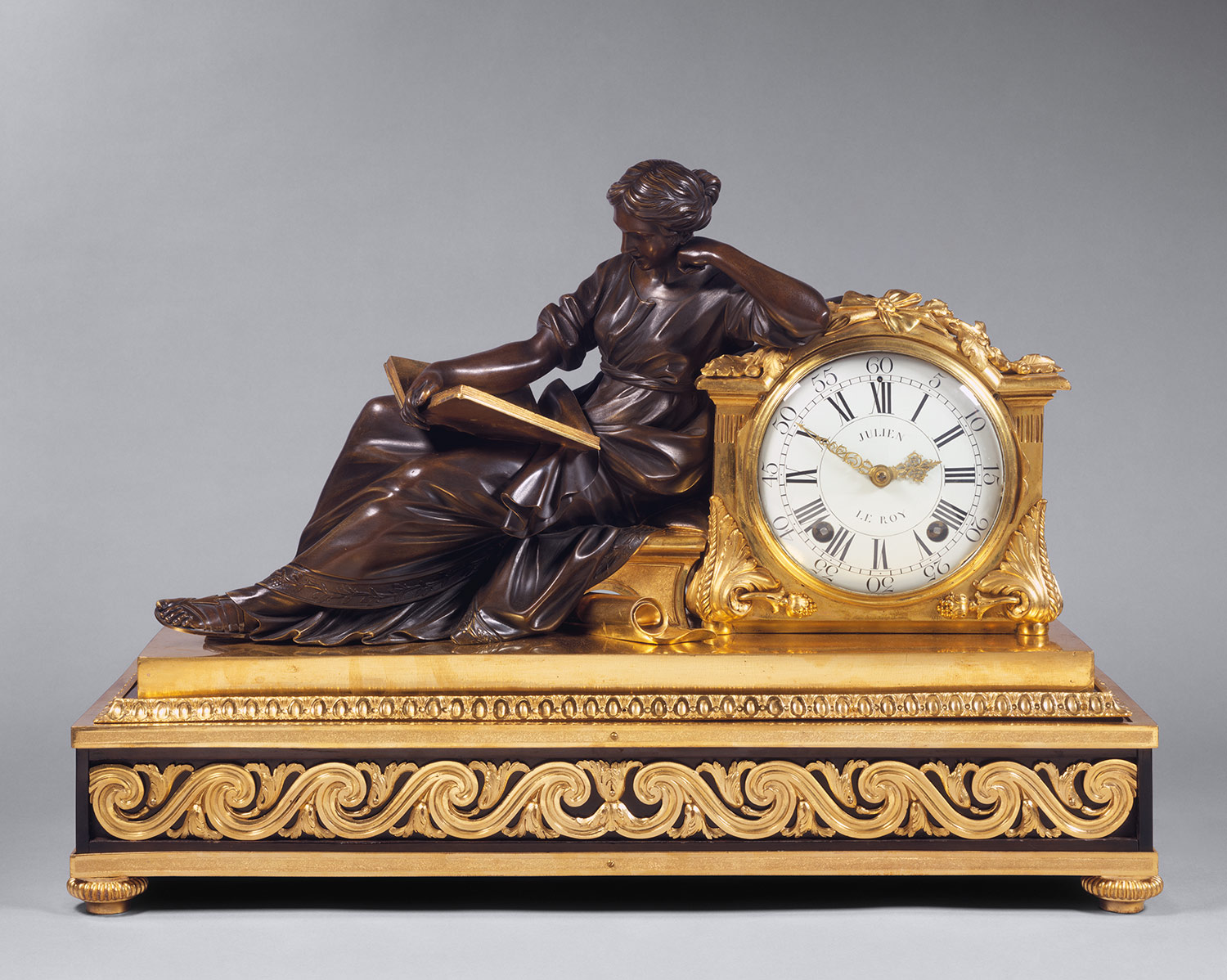
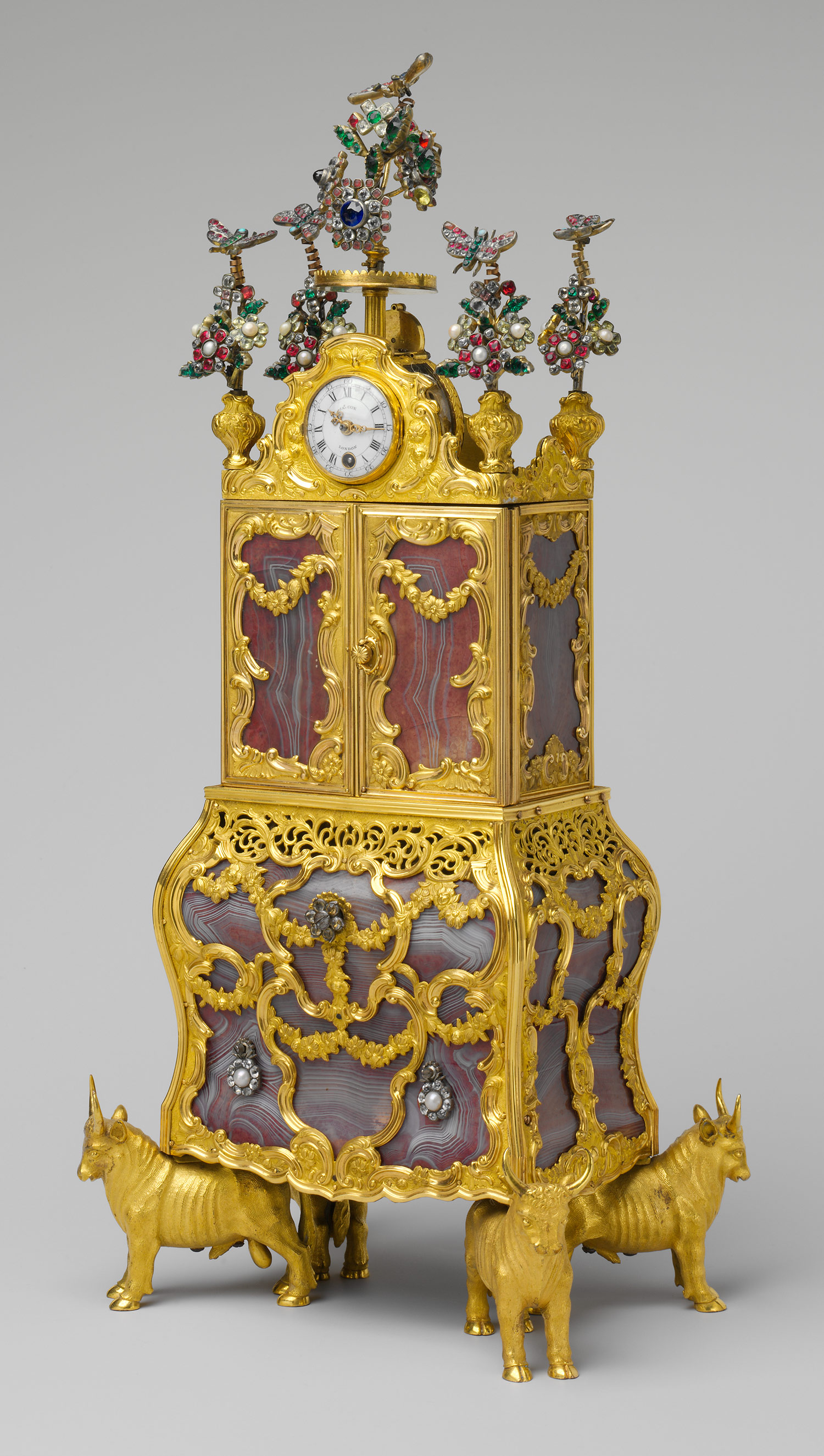
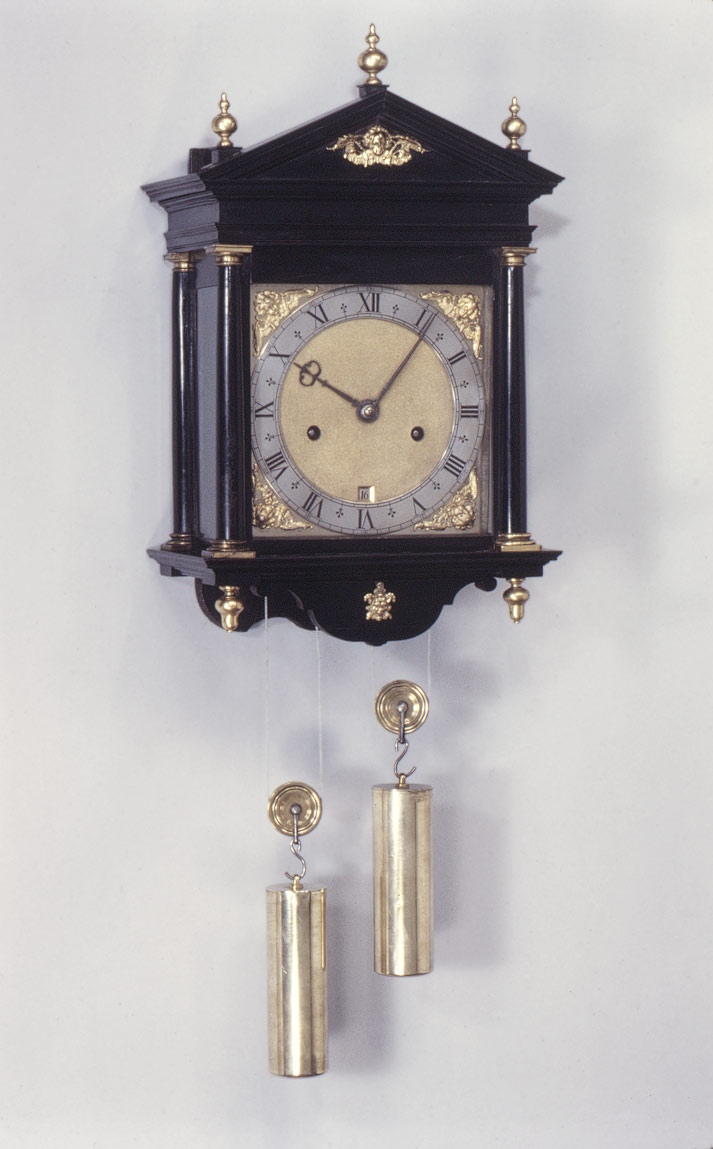 The adoption of the pendulum in the seventeenth century radically changed the European clock. The great advantage of the pendulum for controlling the escapement of a clock is that, unlike earlier controlling devices, the freely swinging pendulum has a definite period of its own. The principle was discovered in Italy by Galileo Galilei (1564–1642), but for the practical purposes of European clockmaking, the development of the pendulum began with the Dutch mathematician Christiaan Huygens (1629–1695). Huygens's first version of the pendulum was invented toward the end of 1656. A year later, Salomon Coster (died 1659) of the Hague obtained exclusive patent rights for making Huygens's pendulum clocks in the Netherlands. The Fromanteels, a prominent family of London clockmakers, sent a family member John (1638–after 1682) to become a journeyman in Coster's workshop, and by November 1658, the Fromanteels were able to advertise their pendulum clocks in London. The Museum's hooded wall clock (1974.28.93) of about 1660–65 by Ahasuerus I Fromanteel (1607–1693), the father of John, is a fine example of an English clock with a traditional verge escapement, now regulated by the newly developed short pendulum derived from Huygens's invention
The adoption of the pendulum in the seventeenth century radically changed the European clock. The great advantage of the pendulum for controlling the escapement of a clock is that, unlike earlier controlling devices, the freely swinging pendulum has a definite period of its own. The principle was discovered in Italy by Galileo Galilei (1564–1642), but for the practical purposes of European clockmaking, the development of the pendulum began with the Dutch mathematician Christiaan Huygens (1629–1695). Huygens's first version of the pendulum was invented toward the end of 1656. A year later, Salomon Coster (died 1659) of the Hague obtained exclusive patent rights for making Huygens's pendulum clocks in the Netherlands. The Fromanteels, a prominent family of London clockmakers, sent a family member John (1638–after 1682) to become a journeyman in Coster's workshop, and by November 1658, the Fromanteels were able to advertise their pendulum clocks in London. The Museum's hooded wall clock (1974.28.93) of about 1660–65 by Ahasuerus I Fromanteel (1607–1693), the father of John, is a fine example of an English clock with a traditional verge escapement, now regulated by the newly developed short pendulum derived from Huygens's invention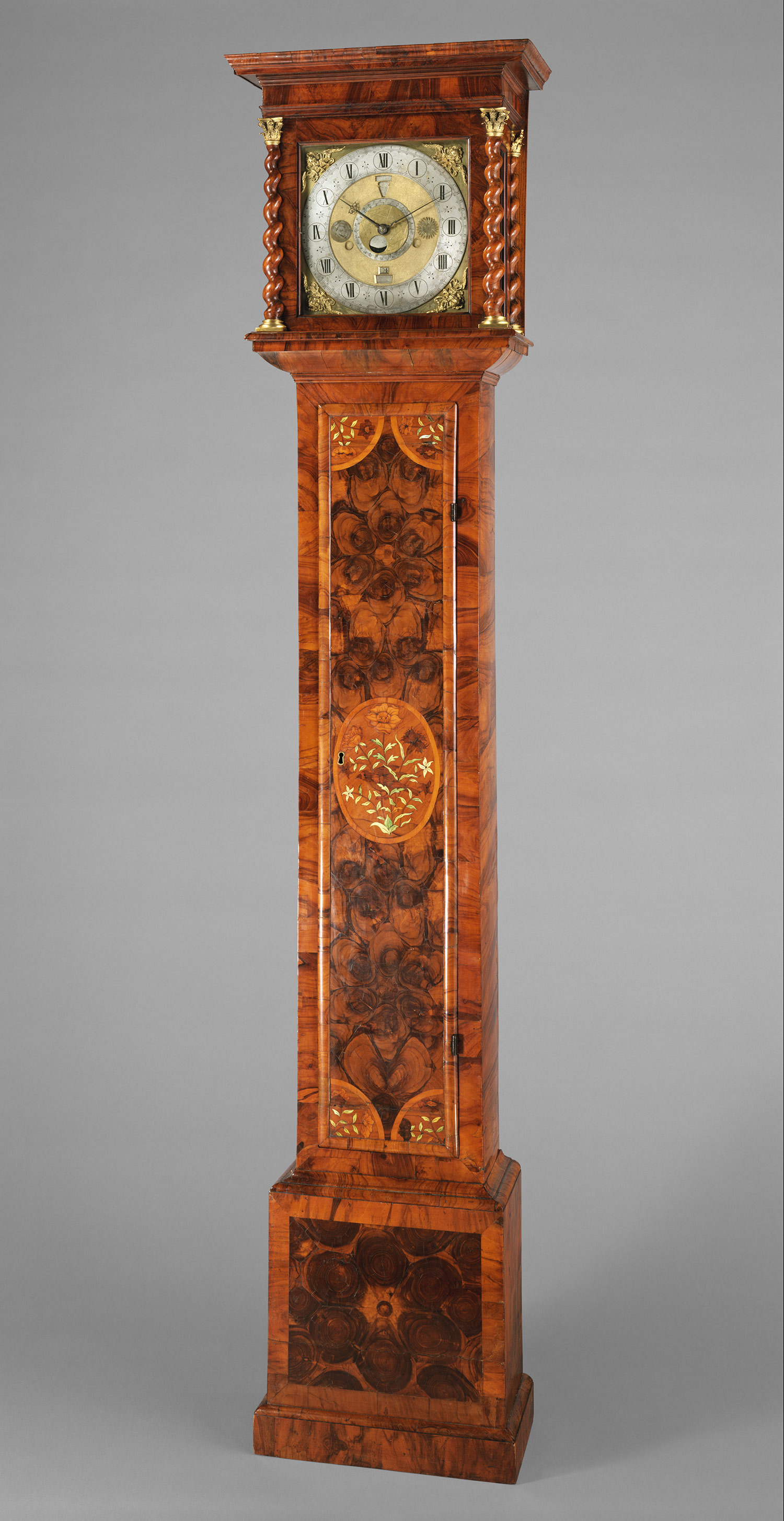
About 1670, Isaac II Thuret (1630–1706), clockmaker to the French king Louis XIV, made a pendulum clock with a dial that indicated hours, minutes, and seconds. Now in the collection of the Museum Boerhaave in Leiden, the clock was, according to tradition, the personal possession of Huygens, and it is the oldest preserved astronomical regulator. A domestic clock (58.53) with a short pendulum probably made by Isaac or perhaps by his son Jacques III Thuret (1669–1738), with a magnificent case and pedestal by André-Charles Boulle (1642–1732), made about a quarter of a century later, is in the Museum’s collection.
Although Huygens published his idea for a precision pendulum in a small booklet titled Horologium in 1658, he did not produce the full theory of the pendulum for the scientific world until the 1673 publication, Horologium oscillatorium sive de moto pendulorum. By that time, English and French clockmakers had already put the pendulum to use, permanently changing the technology of clocks. It remained for the English to complete this development. There were a number of practical problems, however, in making the pendulum the truly accurate timekeeper it was to become. First, the pendulum had to be lengthened and the arc of its swing reduced. A new escapement had to be found to help shorten the arc, as well as to diminish the retarding effect that the older verge escapement had on the pendulum. The standard solution proved to be the anchor escapement regulated by a pendulum of slightly more than thirty-nine inches in length, giving a beat of one second and allowing seconds to be recorded on the dial of a clock without the use of complicated gearing. A weight at the bottom of the pendulum in the form of a double-sided convex disk was found to offer the least resistance to the air. The problem of making a case to stand on the floor to protect the long pendulum as well as the weights of a domestic clock was solved in the course of the seventeenth-century evolution of the longcase—or, more popularly, the grandfather clock. All these features are present in a longcase clock (1999.48.2) of about 1675–78 by Thomas Tompion (1639–1713).
By the end of the seventeenth century, clocks were accurate enough to be used for serious astronomical observation. Tompion had, in fact, made two year-going clocks with thirteen-foot pendulums for the Royal Observatory in Greenwich, England, that were finished in 1676. John Harrison's (1693–1776) chronometer, familiarly known as H. 4, proved that it was possible to solve the age-old problem of finding the longitude at sea by the use of an accurate timekeeper. John Arnold (1736–1799) and Thomas Earnshaw (1749–1829) managed to make chronometers in sufficient quantities and at moderate prices so that by the early nineteenth century the chronometer had become a standard instrument of navigation.
Technical advances and superb workmanship combined to place England at the forefront of clockmaking in the latter part of the seventeenth century and into the eighteenth century, so much so that in 1711, in order to protect the French trade, King Louis XIV banned the importation of English clocks into France. French clockmakers, on the other hand, took full advantage of the luxury trade that flourished in Paris, providing domestic clocks in splendid cases, ranging from products of cabinetmakers such as Boulle in the early part of the period to the cooperative efforts ofbronze founders, porcelain makers, and marble cutters, which began to predominate before the middle of the eighteenth century. The cases were often closely related to the sculpture and smaller decorative objects of the period. Such clocks as a cartel or wall clock (1982.60.84) with a Chantilly porcelain case and a movement by Étienne I Le Noir (1675–1739), or a mantel clock (1991.8) with a patinated bronze figure titled "Time's Employment" (l'Emploi du Temps) and a movement from the workshops of Julien Le Roy (1686–1759) and his son Pierre Le Roy (1717–1785), are fine examples of these decorative domestic clocks.
French clockmakers also contributed to the advancement of precision timekeeping in the eighteenth century; indeed, Ferdinand Berthoud (1727–1807) was making marine clocks, or chronometers, in Paris while Harrison was still trying to convince the English Admiralty that his chronometers could be put to practical use. By 1760, Berthoud had constructed his first marine chronometer, in 1773 he published his Traité des horloges marines, and in 1766 he obtained a standing order for two marine clocks a year for the French navy. Pierre Le Roy made experimental marine clocks and contributed greatly to the technical inventions that were necessary to the construction of a successful marine chronometer.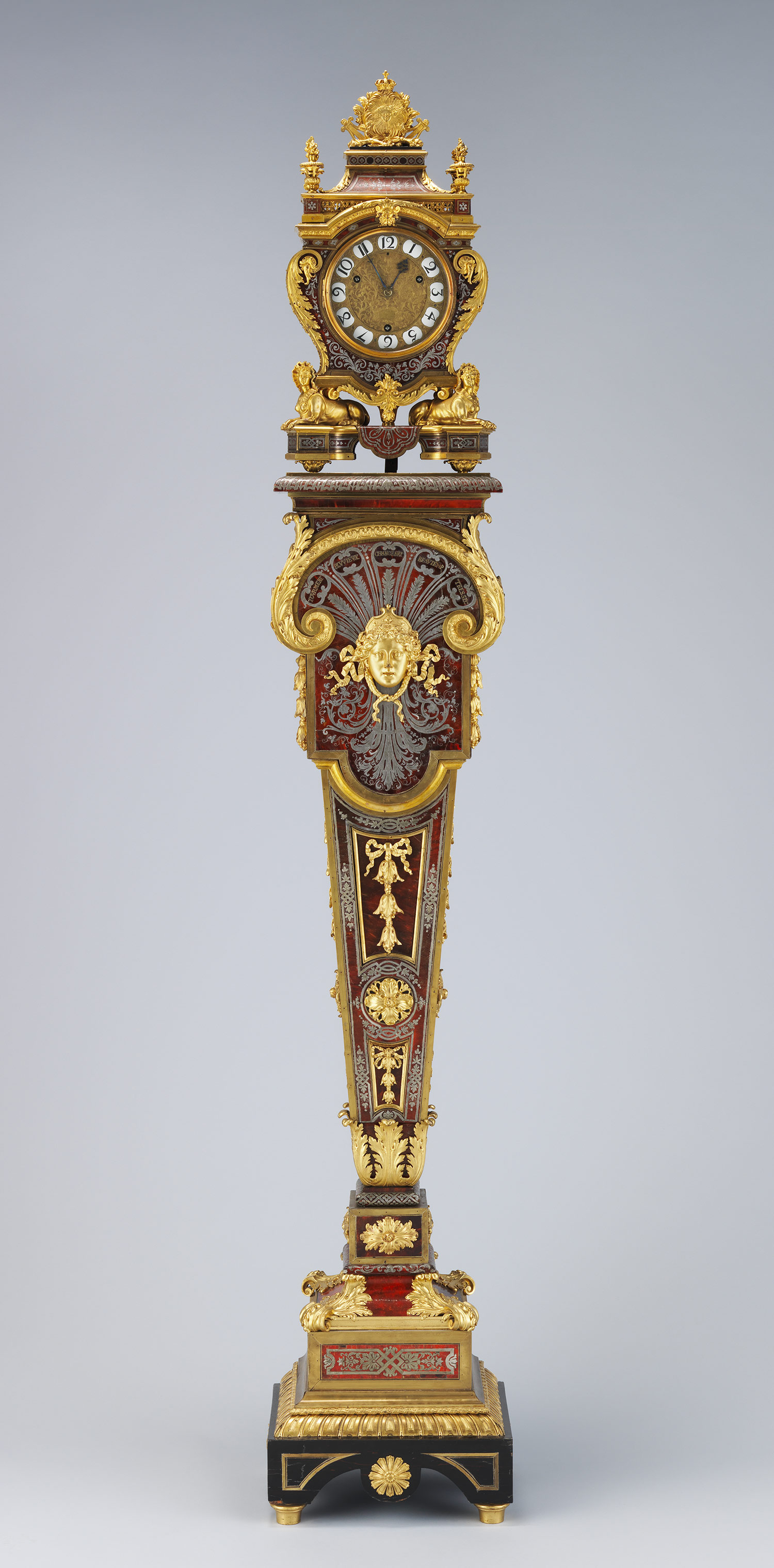
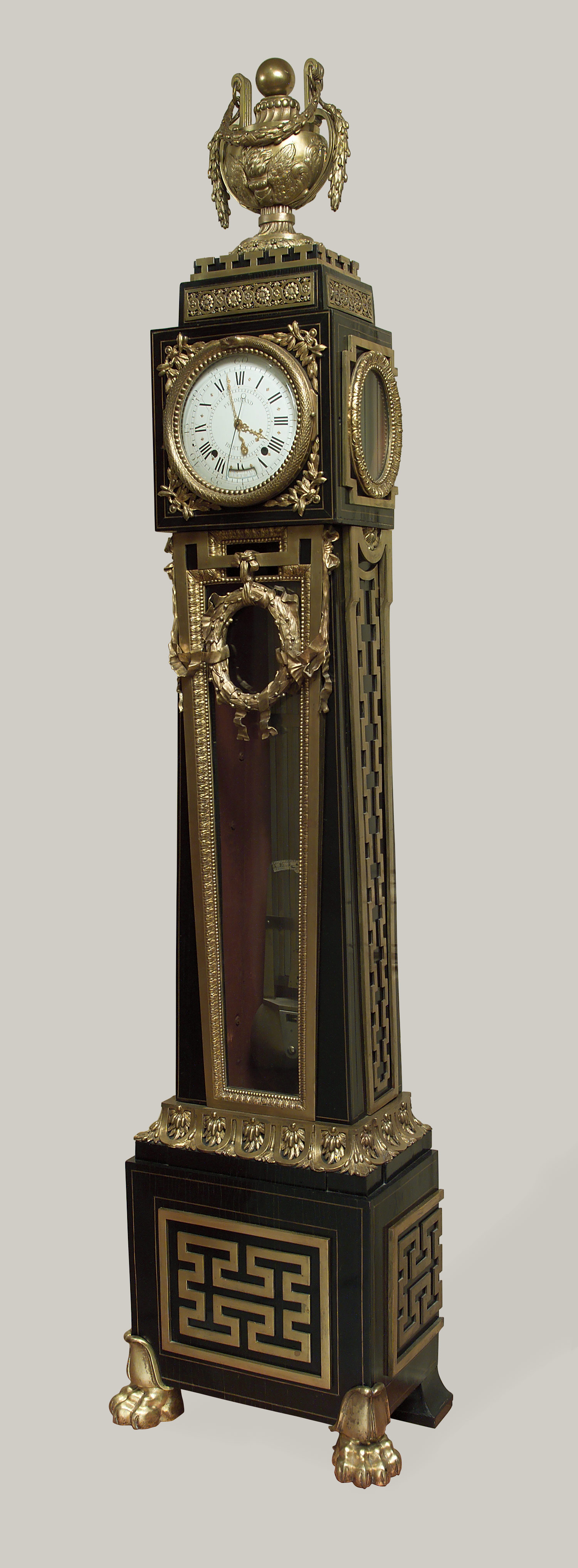
French domestic clocks with long pendulums such as one with a movement by Ferdinand Berthoud (1982.60.50) made use of the improved timekeeping properties of the steel and brass gridiron pendulum invented in England in the 1720s. The clock, made about 1768–70, also incorporates a system of gearing using Berthoud's own variation on the kidney-shaped equation of time disk for indicating the annual irregularities of solar time, a device he published in 1763 in his Essai sur l'horlogerie.
Augsburg, which had been one of the chief suppliers of clocks to all of Europe during the late Renaissance, continued to make domestic clocks, some with highly decorative cases, such as one with repoussé silver reliefs (46.162) by Johann Andreas Thelot (1655–1734), one of Augsburg's most renowned goldsmiths. Augsburg clockmakers never completely exploited the new horological technology, however, and they soon lost their prominence in the history of clockmaking.
Although Huygens published his idea for a precision pendulum in a small booklet titled Horologium in 1658, he did not produce the full theory of the pendulum for the scientific world until the 1673 publication, Horologium oscillatorium sive de moto pendulorum. By that time, English and French clockmakers had already put the pendulum to use, permanently changing the technology of clocks. It remained for the English to complete this development. There were a number of practical problems, however, in making the pendulum the truly accurate timekeeper it was to become. First, the pendulum had to be lengthened and the arc of its swing reduced. A new escapement had to be found to help shorten the arc, as well as to diminish the retarding effect that the older verge escapement had on the pendulum. The standard solution proved to be the anchor escapement regulated by a pendulum of slightly more than thirty-nine inches in length, giving a beat of one second and allowing seconds to be recorded on the dial of a clock without the use of complicated gearing. A weight at the bottom of the pendulum in the form of a double-sided convex disk was found to offer the least resistance to the air. The problem of making a case to stand on the floor to protect the long pendulum as well as the weights of a domestic clock was solved in the course of the seventeenth-century evolution of the longcase—or, more popularly, the grandfather clock. All these features are present in a longcase clock (1999.48.2) of about 1675–78 by Thomas Tompion (1639–1713).
By the end of the seventeenth century, clocks were accurate enough to be used for serious astronomical observation. Tompion had, in fact, made two year-going clocks with thirteen-foot pendulums for the Royal Observatory in Greenwich, England, that were finished in 1676. John Harrison's (1693–1776) chronometer, familiarly known as H. 4, proved that it was possible to solve the age-old problem of finding the longitude at sea by the use of an accurate timekeeper. John Arnold (1736–1799) and Thomas Earnshaw (1749–1829) managed to make chronometers in sufficient quantities and at moderate prices so that by the early nineteenth century the chronometer had become a standard instrument of navigation.
Technical advances and superb workmanship combined to place England at the forefront of clockmaking in the latter part of the seventeenth century and into the eighteenth century, so much so that in 1711, in order to protect the French trade, King Louis XIV banned the importation of English clocks into France. French clockmakers, on the other hand, took full advantage of the luxury trade that flourished in Paris, providing domestic clocks in splendid cases, ranging from products of cabinetmakers such as Boulle in the early part of the period to the cooperative efforts ofbronze founders, porcelain makers, and marble cutters, which began to predominate before the middle of the eighteenth century. The cases were often closely related to the sculpture and smaller decorative objects of the period. Such clocks as a cartel or wall clock (1982.60.84) with a Chantilly porcelain case and a movement by Étienne I Le Noir (1675–1739), or a mantel clock (1991.8) with a patinated bronze figure titled "Time's Employment" (l'Emploi du Temps) and a movement from the workshops of Julien Le Roy (1686–1759) and his son Pierre Le Roy (1717–1785), are fine examples of these decorative domestic clocks.
French clockmakers also contributed to the advancement of precision timekeeping in the eighteenth century; indeed, Ferdinand Berthoud (1727–1807) was making marine clocks, or chronometers, in Paris while Harrison was still trying to convince the English Admiralty that his chronometers could be put to practical use. By 1760, Berthoud had constructed his first marine chronometer, in 1773 he published his Traité des horloges marines, and in 1766 he obtained a standing order for two marine clocks a year for the French navy. Pierre Le Roy made experimental marine clocks and contributed greatly to the technical inventions that were necessary to the construction of a successful marine chronometer.


French domestic clocks with long pendulums such as one with a movement by Ferdinand Berthoud (1982.60.50) made use of the improved timekeeping properties of the steel and brass gridiron pendulum invented in England in the 1720s. The clock, made about 1768–70, also incorporates a system of gearing using Berthoud's own variation on the kidney-shaped equation of time disk for indicating the annual irregularities of solar time, a device he published in 1763 in his Essai sur l'horlogerie.
Augsburg, which had been one of the chief suppliers of clocks to all of Europe during the late Renaissance, continued to make domestic clocks, some with highly decorative cases, such as one with repoussé silver reliefs (46.162) by Johann Andreas Thelot (1655–1734), one of Augsburg's most renowned goldsmiths. Augsburg clockmakers never completely exploited the new horological technology, however, and they soon lost their prominence in the history of clockmaking.
Glossary of Terms
Anchor escapement
Often found in late seventeenth- and eighteenth-century clocks with long pendulums, the device consists of a flat, toothed wheel mounted at the end of the going train of a clock and a separate, semicircular piece of steel with pallets at each end of the semicircle that somewhat resembles a sea anchor. It The anchor escapement engages with the pendulum by means of a short rod, or crutch, attached to the arbor of the anchor at one end oand ending terminating on the other in a fork or slot that clasps the pendulum rod or a pin that fits within a slot in the pendulum rod. When in motion, the anchor rocks to and fro, releasing one tooth of the wheel and catching another, thus releasing the energy of the going train at small intervals, usually of one second in a longcase clock.
Chronometer
In modern usage, a timekeeper of great precision.
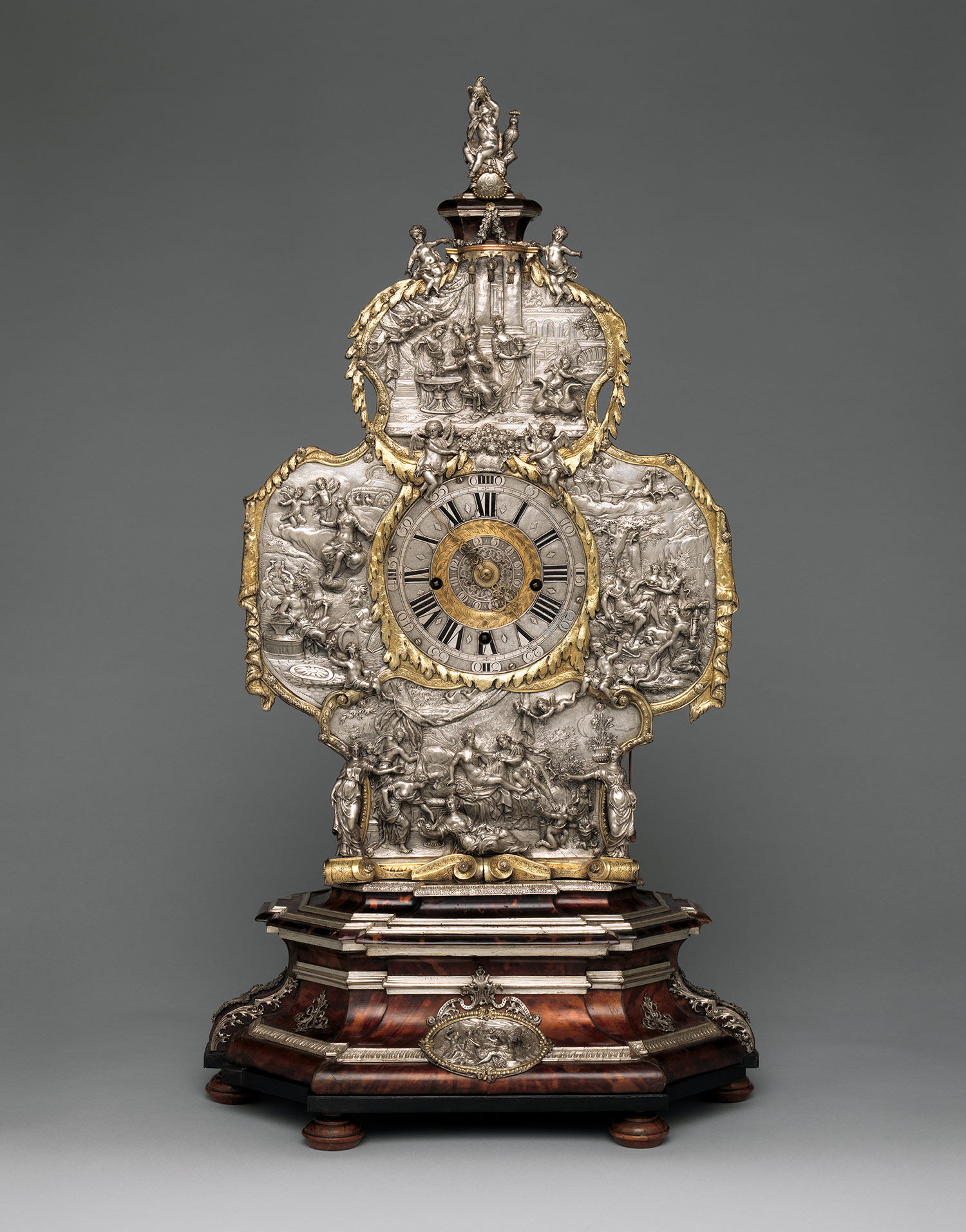
Contrate wheel
A wheel in which the teeth stand up at right angles to the plane of the wheel.
Equation clock
A clock that is made to display true solar time, the time measured by a sundial, which is governed by the diurnal revolutions of the earth in relation to the sun. Usually, such clocks also display mean solar time, or mean time, which is an average drawn from the length of all the solar days in the year and results in a day of exactly twenty-four equal hours. The difference between the two reaches a maximum of a little more than sixteen minutes.
Escapement
The mechanism that converts the continuous motion of the series of wheels, or going train, of a clock to the back-and-forth motion of its regulator.
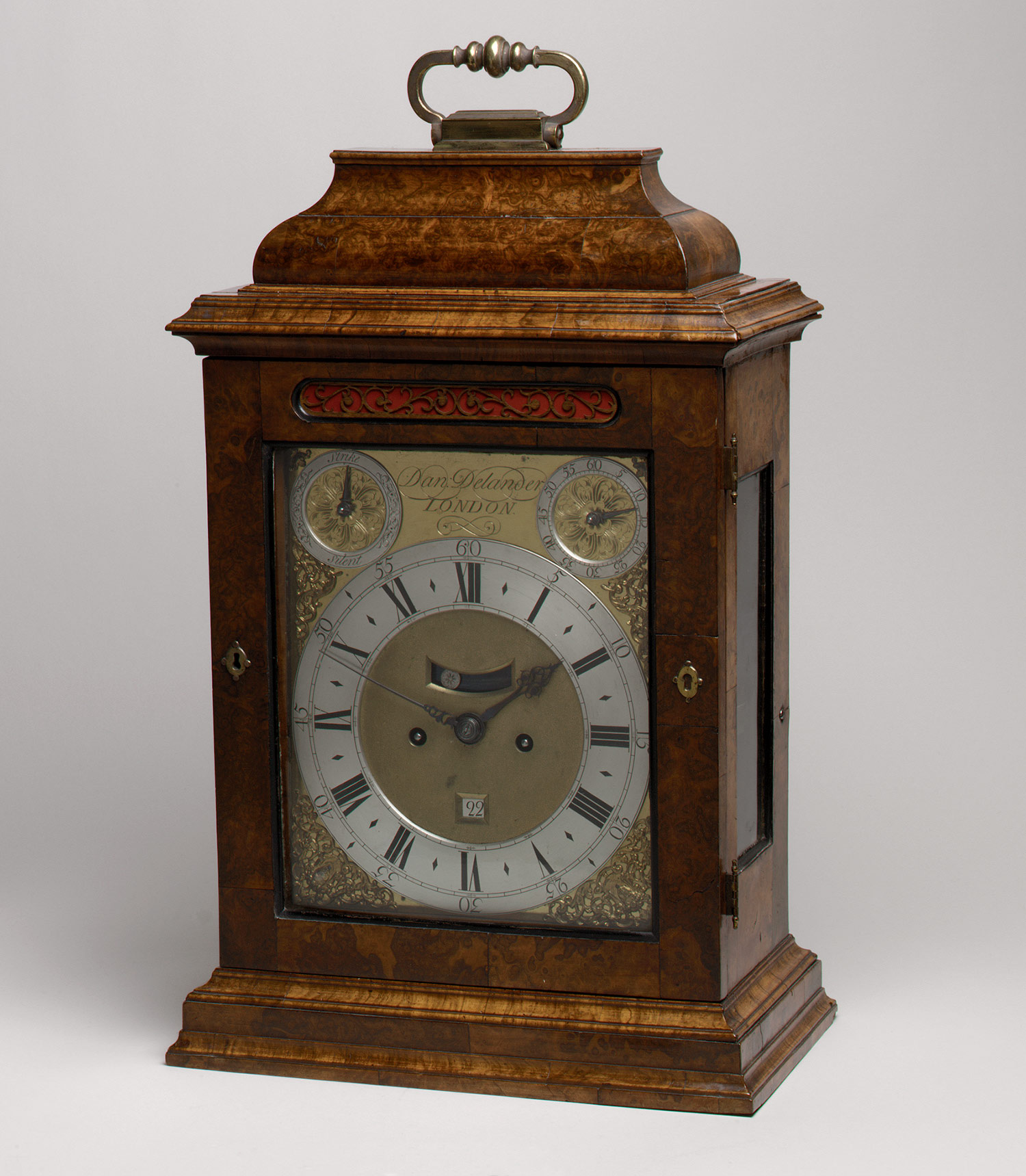
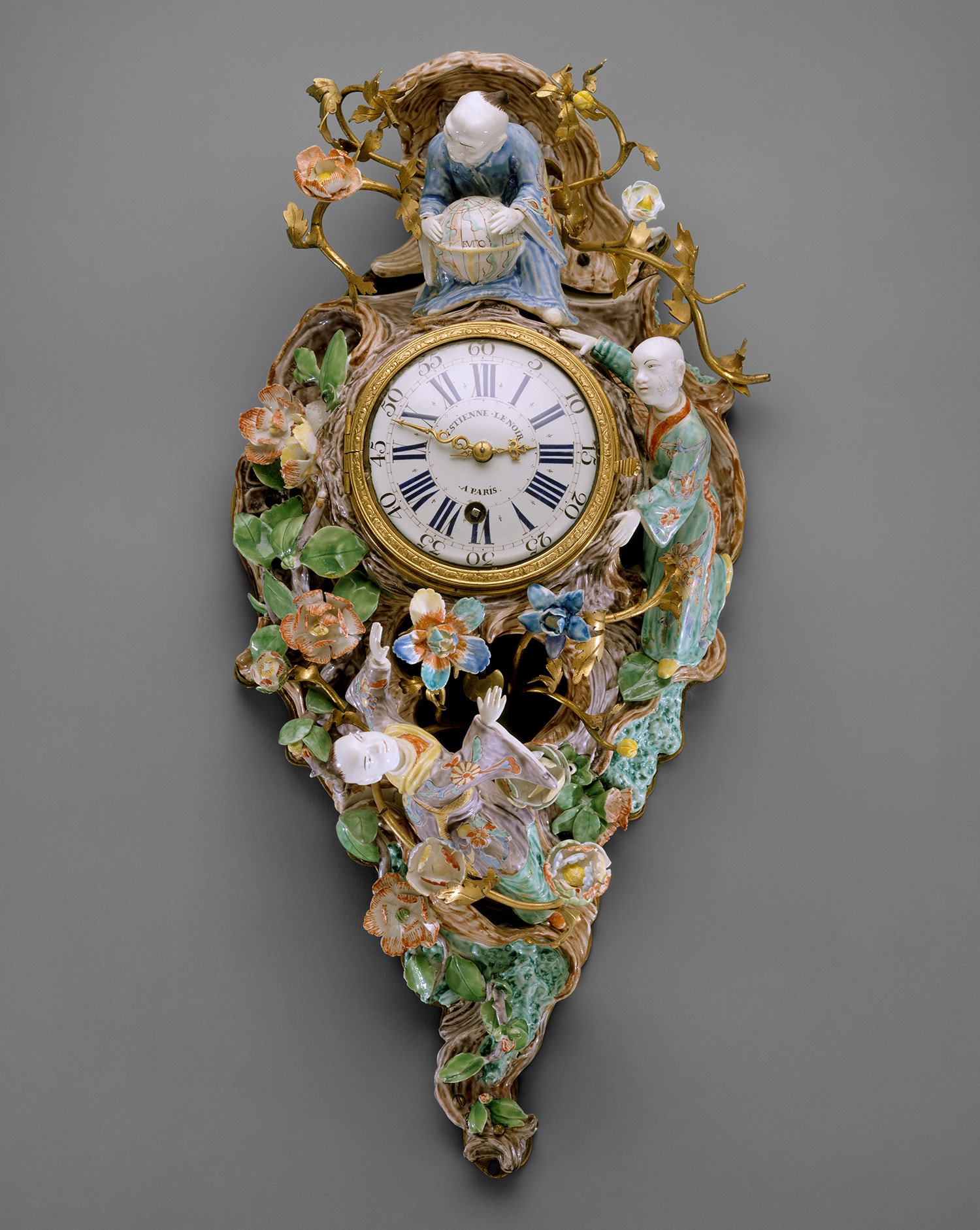
Going train
The series of toothed wheels that connect with a power source and drive the timekeeping mechanism, as well as and the hands, of a clock.
Gridiron pendulum
A pendulum consisting of multiple rods made of two metals (often brass and steel) with differing coefficients of expansion, that are arranged so that the total length of the pendulum remains constant and unaffected by changes in temperature.
Regulator
A stationary clock of great precision. It usually has a seconds-beating, compensated pendulum, whether of the gridiron variety or some other variety, such as the mercury-filled jar, that adjusts to changes in temperature that would otherwise affect the length of the pendulum. Some have specially designed escapements, as well.
Striking train
The series of toothed wheels that connect a power source with a hammer that strikes a bell (usually in seventeenth- and eighteenth-century clocks) and measures out the number of strikes required.
Verge escapement
A toothed wheel that is the last wheel in the going train of a clock across which is placed an arbor, or balance staff, with two pallets, or flags, attached to it in such a way that when the wheel revolves, the teeth of the wheel alternately engage a pallet, releasing the energy of the going train in short, measured intervals. It is the oldest practical form of escapement and can be used with circular balances as well as short pendulums.
Anchor escapement
Often found in late seventeenth- and eighteenth-century clocks with long pendulums, the device consists of a flat, toothed wheel mounted at the end of the going train of a clock and a separate, semicircular piece of steel with pallets at each end of the semicircle that somewhat resembles a sea anchor. It The anchor escapement engages with the pendulum by means of a short rod, or crutch, attached to the arbor of the anchor at one end oand ending terminating on the other in a fork or slot that clasps the pendulum rod or a pin that fits within a slot in the pendulum rod. When in motion, the anchor rocks to and fro, releasing one tooth of the wheel and catching another, thus releasing the energy of the going train at small intervals, usually of one second in a longcase clock.
Chronometer
In modern usage, a timekeeper of great precision.

Contrate wheel
A wheel in which the teeth stand up at right angles to the plane of the wheel.
Equation clock
A clock that is made to display true solar time, the time measured by a sundial, which is governed by the diurnal revolutions of the earth in relation to the sun. Usually, such clocks also display mean solar time, or mean time, which is an average drawn from the length of all the solar days in the year and results in a day of exactly twenty-four equal hours. The difference between the two reaches a maximum of a little more than sixteen minutes.
Escapement
The mechanism that converts the continuous motion of the series of wheels, or going train, of a clock to the back-and-forth motion of its regulator.


Going train
The series of toothed wheels that connect with a power source and drive the timekeeping mechanism, as well as and the hands, of a clock.
Gridiron pendulum
A pendulum consisting of multiple rods made of two metals (often brass and steel) with differing coefficients of expansion, that are arranged so that the total length of the pendulum remains constant and unaffected by changes in temperature.
Regulator
A stationary clock of great precision. It usually has a seconds-beating, compensated pendulum, whether of the gridiron variety or some other variety, such as the mercury-filled jar, that adjusts to changes in temperature that would otherwise affect the length of the pendulum. Some have specially designed escapements, as well.
Striking train
The series of toothed wheels that connect a power source with a hammer that strikes a bell (usually in seventeenth- and eighteenth-century clocks) and measures out the number of strikes required.
Verge escapement
A toothed wheel that is the last wheel in the going train of a clock across which is placed an arbor, or balance staff, with two pallets, or flags, attached to it in such a way that when the wheel revolves, the teeth of the wheel alternately engage a pallet, releasing the energy of the going train in short, measured intervals. It is the oldest practical form of escapement and can be used with circular balances as well as short pendulums.
No comments:
Post a Comment